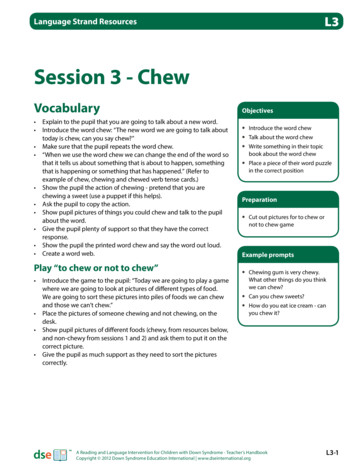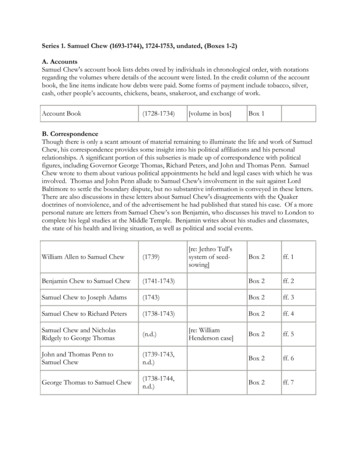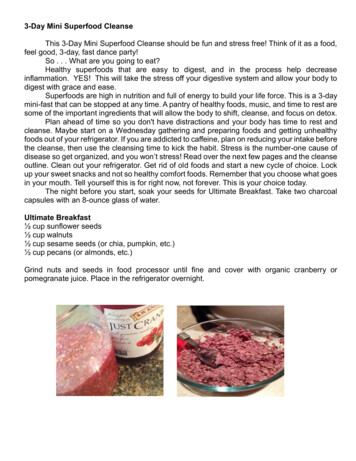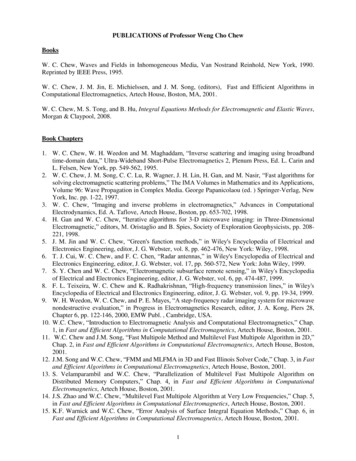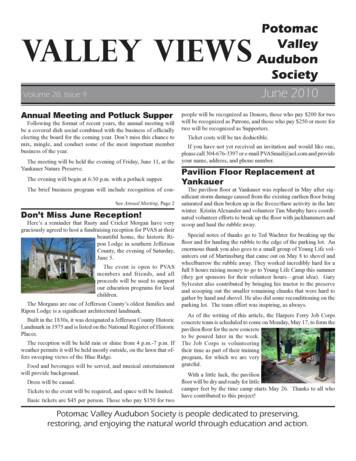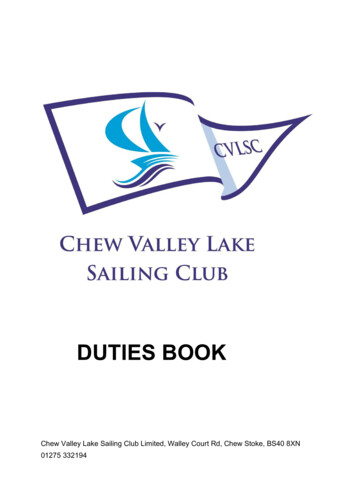
Transcription
DUTIES BOOKChew Valley Lake Sailing Club Limited, Walley Court Rd, Chew Stoke, BS40 8XN01275 332194
CVLSC Duties BookTable of Contents1.General Overview . 21.1.Volunteering for Duties . 21.2.Duty team overview . 21.3.Duty Roles & allocation . 31.4.Responsibilities . 42.Preparing for your duty . 52.1.In advance of the day . 52.2.Backup and support in case of ‘no shows’ . 53.On the day . 63.1.Initial Preparations . 63.2.RIB preparation and responsibilities . 64.Detailed Guidance to assist you on the day . 85.Appendices Containing specific detailed advice & guidelines . 9Appendix 1: Opening the Clubhouse and activating the Lift . 10Appendix 2: Intruder Alarm . 11Appendix 3: CVLSC Safety Policy . 12Appendix 4: Risk Assessment for General Sailing. 15Appendix 5: Buddy Sailing Policy . 16Appendix 6: General Sailing Guidelines . 19Appendix 7: Cold Weather Advice . 21Appendix 8: Radios . 22Appendix 9: Rescue Boat Guidance and Use . 23Appendix 10: Emergency procedures . 27Appendix 11: Defibrillator Algorithm and Information . 30Appendix 12: Provision & Hire of Club Dinghies . 32Appendix 13: Visitors/Guests Fees and Rope charges . 34Appendix 14: SumUp Card Payment Machine . 35Appendix 15: End of Day Close Up Procedure . 36Appendix 16: Locking Up Check Sheet. 37Appendix 17: Lake Map . 3824-Mar-2022Page 1 of 38
CVLSC Duties Book1. General OverviewWe are an entirely voluntarily run club and all members undertake duties as a condition ofmembership. This book summarises each duty role, provides essential information to helpyou on the day to ensure everyone experiences safe and enjoyable sailing. Pleasefamiliarise yourself with the contents, and contact duties@chewvalleysailing.org.uk shouldyou have any questions.1.1. Volunteering for DutiesMost members are required to undertake around 3 duties each year. You can volunteer foryour duties by logging into Dutyman and using the ‘volunteer for a duty’ button on the righthand side – follow the instructions. This enables you to choose the duty types and datesthat suit you, but if not, duties are rostered in batches across the year and you will beallocated 2-3 duties over the year. If needed, you can request duty swaps using Dutyman,or you can switch duty dates if you need to by getting in touch with the Duties Secretary(duties@chewvalleysailing.org.uk).When you are allocated a duty you will receive an email confirming the details; it is importantthat you confirm your acceptance in Dutyman, or mark it as swap wanted and seek swaps atthe earliest opportunity if you are unable to attend. No shows and late drop-outs make it verydifficult to fill gaps in the roster and put pressure on others to cover for you.Duties are allocated on each of our sailing days; on Saturdays, Sundays, Wednesdaydaytime and a few Thursday evenings in the summer, although the latter two are forRescue Helms (although an OOD is also rostered on Wednesday daytimes). Wednesdayevening race duties are rostered separately using those that sail on Wednesday evenings,and are in addition to the normal duty tally.1.2. Duty team overviewThe Officers of the Day, rescue boat team and any race teams run Chew Valley LakeSailing Club on your duty day. You are all entrusted to:1. Open up and lock the clubhouse2. ensure the safe use of the Club and lake throughout the day3. complete the Risk Assessment and exercise judgement to decide if it is safe to sail4. maintain watch over the lake and respond quickly to any kind of problem5. help engender a friendly, welcoming and helpful manner for members and visitorsusing the club6. ensure that we stick to the rules of the Club, including those of Bristol Water.7. be observant of visitors, ensure they pay the required guest fee and are correctlysigned into the Visitors Book.8. deal with payments for the hire of club boats.9. familiarise yourself with the emergency procedures, location of the first aidkits andthe defibrillator and its instructions for use.10. complete the Duty Register (located on the duty desk in the main clubroom),ensuring that all members of the duty team present are recorded and noting any24-Mar-2022Page 2 of 38
CVLSC Duties Bookduty swaps, no-shows, equipment related issues and any accidents or otherincidents.1.3. Duty Roles & allocationAll duties involve a long period of time out of doors so please bring appropriateclothing; allroles may be required to help-out on the water so you must also bring suitable clothing togo out in the rescue boats, including a wetsuit or dry-suit, buoyancy aid, and plenty ofwarm and waterproof clothing.The normal duty roles comprise: Officer of the Day (OOD) Rescue Helm (RH) Rescue Crew (RC) Race Officer (RO) Assistant Race Officer (ARO)The typical daily duty allocation on sailing days is as ningFrom 6pmThursdaySaturdaySundayEveningFrom 6pm10am-6pm10am-6pm11221122121222122Note:1. On those occasions when no OOD is allocated/present the RH can also fulfil thisrole.2. On Wednesday afternoon after 4pm there is no rostered duty cover. Generalsailing is permissible provided rescue cover in accordance with our Buddy Sailingpolicy (Appendix 5) is arranged from assembled sailors3. On Wednesday and Thursday evenings the whole team is responsible for safetyoverview and the club locking up procedure24-Mar-2022Page 3 of 38
CVLSC Duties Book1.4. ResponsibilitiesOfficer of the Day (OOD1 and OOD2) Officers of the Day have overall responsibility for ensuring the safe running of theClub. The rostered OOD or OOD1 is the lead role; OOD2 is usually rostered fromnewer members with little or no experience of the role. OODs may also be called on for rescue crew duties if there are gaps in therostered RIB crew.Rescue Helms (RH) No individual should drive a RIB unless they are suitably qualified as set out inthe Club’s Safety Policy (see Appendix 3) Rescue helms have responsibility for helping ensure safe sailing and assistingsailors in difficulty. On Sundays they will also help the Race Officer by movingmarks.Rescue Crews (RC) Crew the RIBs and assist the rescue helms.Race Officer (RO) Have overall charge of club racing and are jointly responsible for safety with theOODs. Detailed guidance for race officers is in the folder in the race hut. Contact thePRO or one of the flag officers if you have any queries.Assistant Race Officer (ARO) Assist the RO in running club racing; may be called upon for Rescue Duties intheevent of a no-show.There are various other club roles that may assist you on the day:Flag Officers:Commodore, Vice-Commodore, Rear-Commodore may be at the club and available forgeneral help and adviceBackup FleetOn racing days the backup fleet can be called upon to help provide additional rescuehelms/crew if needed. The Fleet Captain should assist in finding volunteers.CLADS (Chew Lake Association of Disabled Sailors)On Saturday mornings when CLADS are sailing, they will have an onshore co-ordinator.Please provide support and assistance as requestedSafety Coordinator/Event coordinator:Large events such as open meetings normally have a dedicated event coordinator/safetyofficer to oversee the event and shoreside operations in relation to the eventorganisation. Please liaise closely with them and assist as required on the day.24-Mar-2022Page 4 of 38
CVLSC Duties Book2. Preparing for your dutyIn advance of the day Please familiarise yourself with the contents of the duty book in advance of yourduty day, together with any additional guidelines in place from time to time A week before the duty day, OOD1 (and OOD2 if rostered) should get in contactwith each other and check that the rest of the team is available by phoning roundusing the contact information on the Dutyman roster. Bear in mind that you mayhave to manage without the other OOD if they’ve dropped out – the RescueHelms are usually experienced club members and can assist and advise on theday. Contact duties@chewvalleysailing.org.uk for advice if needed. If an OOD has not been rostered, the first named Rescue Helm should pleasetake responsibility for phoning around the duty team. If an OOD has been rostered but you aren’t contacted please be pro-active andcontact them directly to confirm your attendance and any special arrangementsfor the day Plan to arrive at 09:00 on weekend sailing days (or at least 1 hour before thescheduled sailing time), to open the clubhouse and prepare everything for sailing.Detailed guidance for everything you are likely to encounter on the day can befound in the appendices2.2. Backup and support in case of ‘no shows’We try our best to arrange all rostered roles in advance, although occasionally illness orlate drop-outs mean that there can be some gaps.If the duty team are short of an OOD: the second OOD (if rostered) should cover the role. There are plenty ofexperienced members around normally that can help out and advise if you areunsure so please ask if you are not familiar with everything. If there is no OOD then the rescue helms should complete the Risk Assessment(Appendix 4) to help determine if the role can reasonably be covered by one ofthem. If this is not possible follow the steps detailed below for a missing rescuehelm.If the duty team is short of a rescue helm (or crew): On Saturdays or Sundays, it may be that another member of the duty team, ifsuitably qualified/experienced, can step in as Rescue Helm. Otherwise request for a volunteer from the assembled sailors over the tannoy inthe Race Hut. If conditions are benign, it may be acceptable to cover sailing with only a onefully crewed RIB, although two RIBs must always be launched and available foruse (the Risk Assessment in Appendix 4 will guide you through considerations inmaking this judgement) On Sundays there is additionally a system of a backup fleet and race officeradvisors. The list can also be found on the noticeboard near the bar. The backupfleet should be notified and asked to help find a suitable volunteer.24-Mar-2022Page 5 of 38
CVLSC Duties Book3. On the day3.1. Initial PreparationsBefore any sailing can commence on the lake you must first unlock the clubhouse (seethe detailed unlocking guidelines in Appendix 1 which will take you through how to dothis step by step), including the intruder alarm guidance (Appendix 2).You will additionally need to: Open the Undercover Boat Store: unlock the single door on the south end of theclubhouse. The lights are automatic. Walk through and open the up-and- overdoors from the inside. These doors too are sensitive; rattling them may set off thealarm. Arrange for the RIB crew to fuel and launch the RIBs in readiness for sailing The RIBs are all equipped with integral radios. If for any reason these aren’tbeing used there are handheld radios in the Secretary’s office that should beissued to RIB drivers. The OOD should also take a handheld radio so that theycan communicate with the RIBs on the water Check wind speed and direction, and water temperature. If the wind has west and/or north in it, i.e. off-shore, the wind speed must bechecked on the water, between mark 4 and mark B. There is a portableanemometer in the drawers of the duty desk. Send a rescue helm out with it tocheck the wind speed. The OODs should convene a brief meeting of the duty team, including any raceofficers or event organisers to:o Discuss weather conditions and any other circumstances that impact uponsafe operationso Confirm provision two fuelled and crewed rescue boats on the watero Complete and sign the appropriate Risk Assessment sheets kept on theduty desk (Appendix 4). Once both rescue boats are launched and the crews are ready, hoist the clubburgee and red ensign (both of which you will find in the Undercover Boat Store)on the main flagpole. Refer to the conditions requiring the use of wetsuits or dry-suits as set out inAppendix 7. If wetsuits are required, also hoist code flag ‘W’ on the mainflagpole.3.2. RIB preparation and responsibilitiesPlease look after RIBs as if they were your own.The RIBs are our primary life-saving equipment.During the summer months when the lake is low, please take care around theedges of the lake and around shallow areas such a ‘Little Denny’ (see lake map inAppendix 17) – a ‘shoulder’ of shallow water between Denny Island and Mark 4,and the jetty that extends out submerged between the RIB launch area and the RIBpontoon.24-Mar-2022Page 6 of 38
CVLSC Duties BookTogether with the OOD, you have responsibility for: The safety of all activities on the lake during your period of duty. This meansmaintaining a continuous watch of the lake. On rare occasions you may be called on to assist an angler in a fishing boat. On race days please do not neglect keeping a watch on the recreational sailors.They may be more at risk then the racers.Safety on the water is paramount. Please read and familiarise yourself with our clubsafety policy, but in summary: 2 RIBs should be available for rescue duties at any one time although in benignconditions, it is acceptable for a single RIB only to be fully crewed One of the RIBs should ALWAYS be manned by a qualified helm and a crew. It isextremely difficult for assistance to be given to a sailor by a single person in aRIB It is expected that one of the rescue boats patrols on the water at all times whensailing is taking place. If a RIB is dedicated to training then this is in addition to the two rescue RIBsunless expressly agreed otherwise by the OOD. If the rescue boats cannot be crewed in accordance with the club safety policy,all sailing must cease until additional volunteers are foundNote: A single RIB with one person may be used to check wind speed and to prepareracing marks provided a second RIB is being readied for use should the first encounterany incident. THIS IS NOT ADEQUATE TO ALLOW SAILING TO BEGINWhen using the RIBs abide by the following requirements: RIB helms are responsible for completing the equipment check detailed in theAppendix 9 before launching, and for remedying any problems Always wear adequate clothing and a buoyancy aid. It is always colder crewing aRIB than it is sailing a dinghy. Be prepared for complete immersion. ALWAYS use the kill cord. Priority MUST be given to assisting people before the recovery of boats. Safety boats must be driven carefully and not cause problems to other lakeusers. Travelling round the lake at high speed is NOT necessary or desirable Use low speeds to maximise fuel use, help prolong engine life and minimisedisturbance When recovering people from the water the RIB helm MUST stay between thecasualty and the engine. When going afloat practise slow speed manoeuvring. This is essential when youare required to carry out a rescue. Unqualified crew can receive driving experience only under the guidance of aqualified helm. No ‘joy riding’ or ‘family trips’.24-Mar-2022Page 7 of 38
CVLSC Duties Book The helm will be in charge of the safety boat and will be responsible for thesafety of the boat and crew.4. Detailed Guidance to assist you on the dayDetailed guidance on specific areas of operation can be found in the followingappendices, but in general the duty team should all work to: Ensure a constant watch is kept on boats sailing. Ensure the rescue team afloat are properly attired and are wearing buoyancyaids. Ensure members behave sensibly and responsibly and comply with Health andSafety directives. Check the sign-in sheet and make sure this is being completed by arrivingmembers. Announce any material matters (e.g. restriction of sailing area) on the clubtannoy (Race Hut). Assist members wishing to hire club boats and take appropriate hire fees usingthe card machine Help welcome guests and take fees for sailing visitors using the card machine Respond and take calls from club telephone when possible. Keep the site tidy; empty bins and check for litter around the site. You will findspare waste sacks in the cupboard just inside the male changing room entrance.Place full bags one of the waste bins opposite the front entrance. Ensure cars park neatly to maximise space in the car park and especially ensurethat the approach road is kept clear (parking is expressly prohibited by BristolWater). If CLADS are sailing, assist them by reserving the end spaces near the frontentrance so as to give free access for their large trimarans to pass. Also ensurethe lift is unlocked and activated and ensure vehicles are not obstructing theramp. There is to be no swimming other than as a result of an accidental capsize, anddogs are not allowed on site, neither in nor out of cars. Help put out and return tables at lunchtime. Clear slipways of algae and goose droppings. Hard blue bristle brushes can befound in the Undercover Boat Store. Complete the Duty Register fully. The section on numbers of members signed in,boats on the water, visitors etc. is ESSENTIAL information for returns to BristolWater and the RYA, and helps build a picture when we apply for grants.24-Mar-2022Page 8 of 38
CVLSC Duties Book5. Appendices Containing specific detailed advice & guidelinesAppendix 1: Opening the clubhouse and activating the liftAppendix 2: Intruder alarmAppendix 3: CVLSC Safety PolicyAppendix 4: Risk assessment for general sailingAppendix 5: Buddy Sailing PolicyAppendix 6: General sailing guidelinesAppendix 7: Cold weather adviceAppendix 8: RadiosAppendix 9: RIB Guidance and UseAppendix 10: Emergency ProceduresAppendix 11: Defibrillator Algorithm and InformationAppendix 12: Provision and hire of club dinghiesAppendix 13: Visitor/Guest fees & Rope chargesAppendix 14: SumUp card machineAppendix 15: End of day closing procedureAppendix 16: Locking up checklistAppendix 17: Lake Map24-Mar-2022Page 9 of 38
CVLSC Duties BookAppendix 1:Opening the Clubhouse and activating the LiftThe standard opening time is normally 09:00 and at least 1 hour before the scheduledsailing time.App1.1. Outer GateBristol Water require that the outer gate is kept locked unless there is an open eventinvolving visitors, in which case the gate may be left unlocked, but closed. In this case, toprevent inadvertent re-locking, take the lock off the gate and leave it on the key hook bythe duty desk in the clubhouse.App1.2. Inner GateThere is gate at the entrance to the dinghy park. This should be opened and left openduring the sailing day.App1.3. Signing-in HutThe signing-in hut is adjacent to the dinghy park gate.You will need to collect the Open the hut using your club key; leave a new sign-in sheetwith a pen, in the aperture, so members can sign in. Collect any previous sign-in sheetsand once in the clubhouse transfer the data to the Duty Register for that day.App1.4. Collect clubhouse key setThe clubhouse keys are located in a steel wall box, behind a steel security gate underthe race hut terrace stairs. Your club gate key will open the padlocks on the security gateand the key box. The steel wall box contains a large key ring with numbered keyscorresponding to the various numbered access points of the clubhouse.App1.5. Entrance to the clubhouse1. Open the main entrance door. Unlocking this door deactivates the alarm. (Take careto read the instructions on the door or you may accidentally re-activate the intruderalarm.)2. In icy conditions – there is salt grit available for use on the steps and entranceway.3. Open the Undercover Boat Store.4. Open the upper terrace doors.5. Open the Race Hut. Turn on the tannoy – it is situated on the right just inside thedoor. There is a mains switch below it and a push button on/off switch on thefront right of the amplifier. Test the tannoy by pressing the red button on themicrophone on the shelf under the window and saying a few words.6. If racing is planned, open the Signing-on Room.7. Open the Training Room.App1.6. The LiftUnlock the lift building entrance door situated in the carpark and activate the lift foroperation by entering the lift and turning the red emergency stop button. Thebutton should pop outwards and the red light will extinguish.Please run the lift up and down again once to warm it up. The lift is now ready foruse.24-Mar-2022Page 10 of 38
CVLSC Duties BookAppendix 2:Intruder AlarmThe alarm system will activate/deactivate as you open up or lock the clubhouse. You donot need to do anything to set or deactivate the alarm other than follow the stepsdetailed in the respective guidelines.There are three zones that the alarm system sets as keys are used to exit the area:1. Undercover Boat Storeset when exiting door 122. Secretary’s Officeset when exiting door 103. Front doorset when exiting door 22Each time these areas are disarmed/re-armed, an audible beep will be heard in the mainclubroom and Bar to alert that this area is being accessed/exited.Should you somehow manage to set off the alarm it will initially ring for around 15minutes and then will try to re-arm itself. So if you have left and locked the buildingcorrectly, the alarm will be set.If however this proves not to be the case, you will need to call one of the individualslisted on the sign attached to the cupboard within the accessible toilet on the first floor.These people will be able to instruct you to open the cupboard and to reset the alarm.If you arrive and you find the alarm unset and there is evidence of entry or disturbance,please contact one of the Flag Officers for advice.Please note the actions you have taken on the Duty Register and the Locking Up CheckSheet at the end of the day.Police may need to be contacted so please preserve evidence as much as possible.Should the alarm fail to disarm on entry, the alarm panel is behind a small door withinthe accessible toilet on the first floor. There are contact details on the door with details ofwho has access. Please contact the alarm company who also know the number andfollow their instructions to disarm the system.24-Mar-2022Page 11 of 38
CVLSC Duties BookAppendix 3:24-Mar-2022CVLSC Safety PolicyPage 12 of 38
CVLSC Safety PolicyIn accordance with bye-laws 1.2 and 8, MEMBERS AND OTHER USERS OF OUR LAKE MUSTTAKE RESPONSIBILITY FOR THEIR OWN SAFETY BOTH AFLOAT AND ASHORE. THE CLUBWILL USE ITS BEST ENDEAVOURS TO PROVIDE ON-WATER SAFETY COVER, BUT THATDOES NOT ALTER THE INDIVIDUAL RESPONSIBILITY OF ALL USERS OF THE LAKE.ACCEPTANCE OF THIS POLICY IS A CONDITION OF GOING AFLOAT AT CHEW VALLEY LAKE.This statement is important because it explains how the Club sets out to assist you withyour safety on the water. PLEASE TAKE THE TIME TO READ IT.SAFETY COVERThe Club will arrange safety cover for those afloat as follows:Two safety boats should always be launched, and at least two “qualified” helms will be inattendance.The duty team will have a collective responsibility for decisions about safety boat provisionand sailing restrictions throughout the dayAt the start of any sailing day the OOD (rescue helms on Wednesday and Thursday) shouldconvene a brief meeting of the duty team, any race officers or event organisers and performa risk assessment relating to safety boat provision. More detailed risk assessments will beneeded for events and formal training. This assessment will have to take into account windand gust strength and wind chill. If the wind has any degree of west in it, wind strengthshould be assessed well out in the middle of the lake near mark B. Following thisassessment decisions should be made about the number of safety boats on the water, theirmanning and tactical positioning. Liaison with the whole team should continue throughoutthe day, reviewing the changing conditions and responding accordingly. Safety boats should at all times be manned by two people, who should beappropriately dressed and prepared to stay out on the water for long periods and atleast one should be prepared to go in the water.Unless the conditions are benign there should always be at least two safety boatseach crewed with 2 people. Therefore the club will now be rostering 2 safety boathelms and 2 crews and 2 OOD’s at weekends.The safety boat helms should have at least power boat level 2, or 3 years equivalentexperience and have completed the CVLSC Advanced Rescue Helm safety training.From April 2019 this training will be mandatory.The rostered safety boat helms will split between the RIBsAll the OODs and safety boat helms and crews should come to the club with clothingsuitable for manning a safety boat and going into the water. Wetsuits are aminimum, but dry-suits are usually more appropriate and buoyancy aids shallalways be worn.
On Wednesdays and Thursdays, when no OOD is rostered the safety helms also actas Officers of the Day. On these days, through the risk assessment, the duty teammust decide if a second safety boat should be manned by volunteers and ensurethat there are 2 fully manned safety boats before sailing is allowed.A safety boat should be out on the water at all times when there is any sailingunderway as there is the risk of undue delay in attending an entrapment if thesafety crew are on the balcony.A watch from the balcony should be kept at all times (by OOD on Saturdays andSundays relaying relevant information to the safety boats with a hand held radio).“Code Red” radio procedure, similar to Mayday. This is only be used in the event ofa serious injury or life threatening emergency on the water. On calling “Code Red”all the available club powered boats should be ready to help the emergency. TheOOD/event coordinator should take control of the radio traffic, continuing to usechannel 37a or M1, and only radio calls related to the emergency are allowed untilthe crisis is over. The likelihood is that any races in progress will have to beabandoned.All members should make themselves aware of the emergency procedures and code red.See section 3.6 of the Duty book.INDIVIDUAL RESPONSIBILITIESAs a Club member or visitor, you have a duty to both yourself and to other lake users asregards safety. This duty means acting responsibly whilst on Club premises, including inthe use of the boat park and winches and in the supervision of your children. You canimprove your own on-water safety by adopting the following: – Check the information board at the main entrance.Remain in the sailing area designated for the day.Less confident sailors – stay in an area where you can be easily seen and quicklyreached.Do not sail in a boat or in weather conditions that are beyond your competence.If in doubt – ask the rescue helms to watch out for you or your child.Your duty to other members and visitors includes: – Providing help or seeking help for anyone you see needing it on the water.Alerting the rescue helms to any situation that you observe that may need theirattention.
CVLSC Duties BookAppendix 4:Risk Assessment for General Sailing(More detailed risk assessments are needed for events and formal training.)This form should be completed by the OOD on each sailing day (or the Race Officer on Weds evenings)and for groups sailing under the buddy sailing policy. If no OOD is rostered, or sailing is continuing underthe buddy sailing policy after the conclusion of rostered duty periods, the person taking responsibility foroverseeing sailing on the lake should complete this form in it’s entiretyReminder: No sailing is allowed until 2 RIBs are launched on the lake and are available for useRisk to be asses
CVLSC Duties Book 06-Jun-20 Page 3 of 35 1 General Overview Ensuring safe and enjoyable sailing on Chew Valley Lake Chew is an entirely voluntarily run club. Our sailing opportunities are dependent on every member supporti
